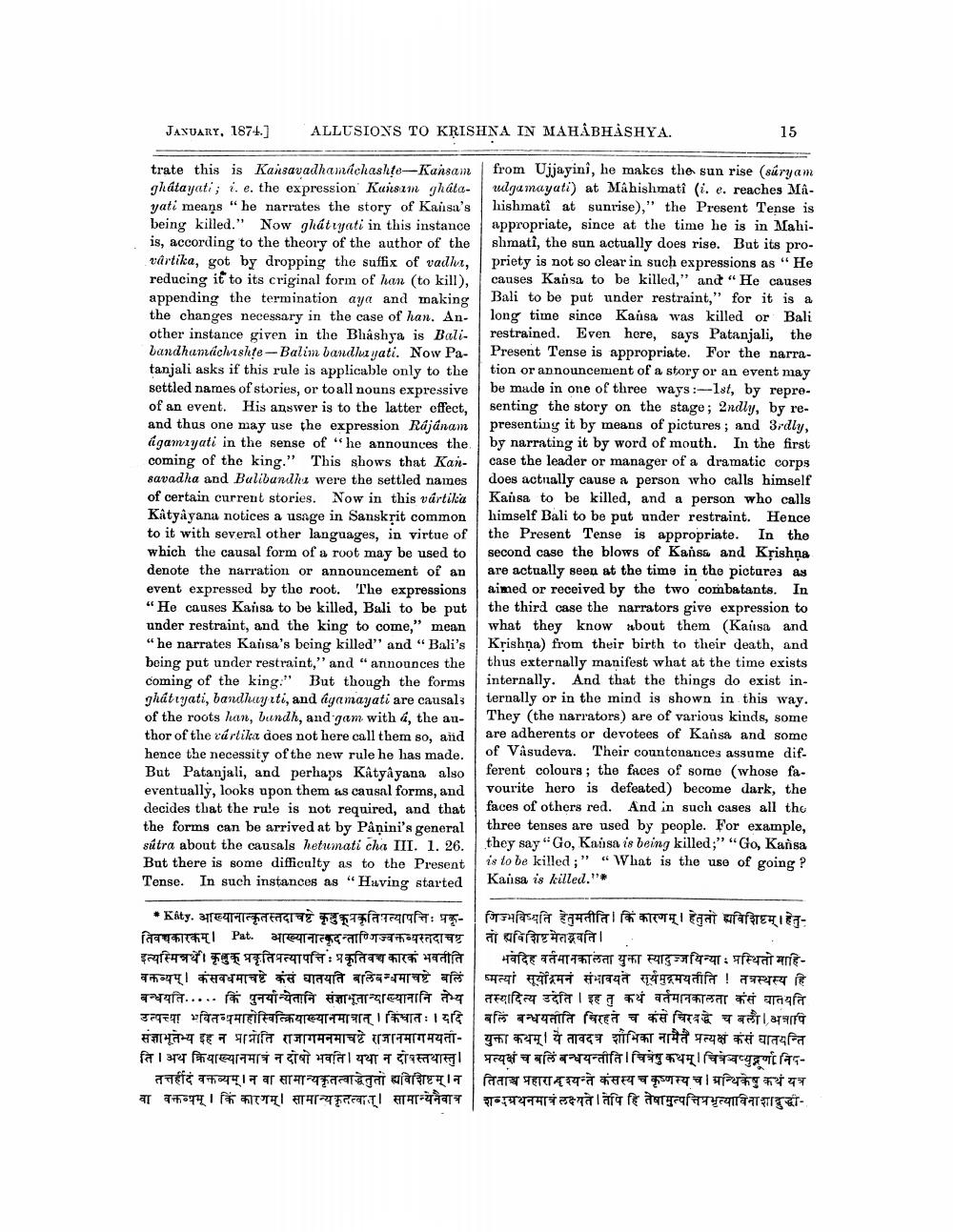________________
JANUARY, 1874.]
ALLUSIONS TO KRISHNA IN MAHÅBHASHYA.
15
trate this is Kansavadhauntchashto Kansan ghatayati; i. e. the expression Kuisam ghatayati means "he narrates the story of Kausa's being killed." Now ghátryati in this instance is, according to the theory of the author of the vårtika, got by dropping the suffix of vadlui, reducing it to its criginal form of han (to kill), appending the termination aya and making the changes necessary in the case of han. Another instance given in the Bhashya is Bali. bandhamáchvushte-Balim bandluz yati. Now Patanjali asks if this rule is applicable only to the settled names of stories, or to all nouns expressive of an event. His answer is to the latter effect, and thus one may use the expression Rájánam agamiyati in the sense of "he announces the coming of the king." This shows that Kan. savadha and Balibanillu were the settled names of certain current stories. Now in this vártika Katyayana notices a usage in Sanskrit common to it with several other languages, in virtue of which the causal form of a root may be used to denote the narration or announcement of an event expressed by the root. The expressions "He causes Kansa to be killed, Bali to be put under restraint, and the king to come," mean "he narrates Kansa's being killed" and "Bali's being put under restraint," and "announces the coming of the king." But though the forms ghátryati, bandhayiti, and ayamayati are causals of the roots han, bundh, and gam with 4, the author of the cartika does not here call them so, and hence the necessity of the new rule he has made. But Patanjali, and perhaps Katyayana also eventually, looks upon them as causal forms, and decides that the rule is not required, and that the forms can be arrived at by Panini's general sútra about the causals hetumati cha III. 1. 26. But there is some difliculty as to the Present Tense. In such instances as "Having started
from Ujjayini, he makos the sun rise (súryam uulga mayati) at Mahishmati (i. e. reaches Mahishmati at sunrise)," the Present Tense is appropriate, since at the time he is in Mahishmati, the sun actually does rise. But its propriety is not so clear in such expressions as "He causes Kansa to be killed," and "He causes Bali to be put under restraint," for it is a long time since Kansa was killed or Bali restrained. Even here, says Patanjali, the Present Tense is appropriate. For the narration or announcement of a story or an event may be made in one of three ways:-1st, by representing the story on the stage; 2ndly, by representing it by means of pictures ; and 3rdly, by narrating it by word of mouth. In the first case the leader or manager of a dramatic corps does actually cause a person who calls himself Kausa to be killed, and a person who calls himself Bali to be put under restraint. Hence the Present Tense is appropriate. In the second case the blows of Kansa and Krishna are actually seen at the time in the pictures as aimed or received by the two combatants. In the third case the narrators give expression to what they know about them (Kaisa and Krishna) from their birth to their death, and thus externally manifest what at the time exists internally. And that the things do exist internally or in the mind is shown in this way. They (the narrators) are of various kinds, some are adherents or devotees of Kansa and some of Vasudeva. Their countenances assume dif. ferent colours ; the faces of some (whose favourite hero is defeated) become dark, the faces of others red. And in such cases all the three tenses are used by people. For example, they say "Go, Kaisa is being killed," "Go, Kansa is to be killed ; " " What is the use of going? Kaisa is killed."*
* Katy. TEACIT Tatar:
T TF are caufati Tilaait wraf TEHICH तिवचकारकम्। Pat. आख्यानात्कृदन्ताणिज्वकव्यस्तदाचष्ट | तो विशिष्ट मेतद्भवति। .. इत्यस्मिनथें। कृलुक् प्रकृतिप्रत्यापत्ति प्रकृतिवच कारकं भवतीति भवदिह वर्तमानकालता युका स्यादुज्जयिन्या प्रस्थितो माहिवक्तव्यम्। कंसवधमाचष्टे कंसं घातयति बालबन्धमाचष्टे बलिं मत्यां सूर्योद्रमनं संभावयते सूर्यमुद्रमयतीति ! तत्रस्थस्य हि बन्धयति..... किं पुनर्यान्येतानि संज्ञाभूतान्याख्यानानि तेभ्य | तस्यादित्य उदेति । इह तु कथं वर्तमानकालता कंसं घातयति उत्पत्त्या भवितपमाहोस्विक्रियाख्यानमात्रात् । किंधातः । यदि बलिं बन्धयतीति चिरहते च कसे चिरबद्धे च बलौ। अनापि संज्ञाभूतेभ्य इह न पामोति राजागमनमाचष्टे राजानमागमयता- युका कयम् । ये तावदत्र शोभिका नामैतै प्रत्यक्ष कंसं घातयन्ति ति । अथ क्रियाख्यानमात्र न दोषो भवति । यथा न दोषस्तथास्तु। प्रत्यक्षं च बलिं बन्धयन्तीति चित्रेषु कथम् । चित्रवप्युद्गर्णा निप
तत्तहीदं वक्तव्यम् । न वा सामान्यकृतत्वाद्धेतुतो ह्यविशिष्टम् । न तिताश्च पहारा दश्यन्ते कंसस्य च कृष्णस्य च । अन्थिकेषु कथं यत्र वा वक्तव्यम् । किं कारगम्। सामान्यकृदत्वात्। सामान्येनैवात्र | शब्दपथनमात्र लक्ष्यते । तेपि हि तेषामुत्पत्निप्रभृत्याविनाशाद्रुद्धी




